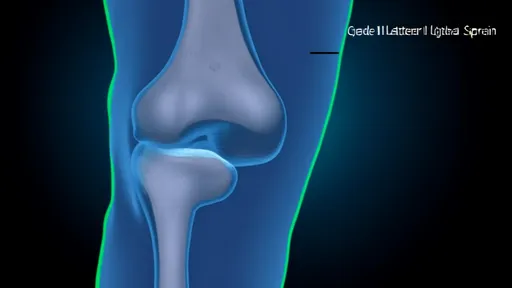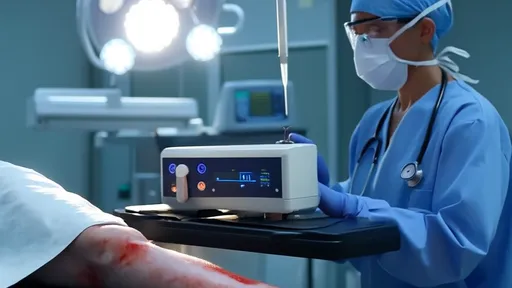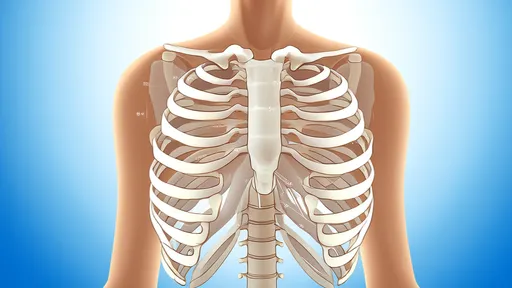The medical community has long been fascinated by the intricate relationship between skeletal deformities and their underlying causes. Among these, costal arch deformities, particularly those involving the lower ribs, present a unique challenge for both diagnosis and treatment. Often referred to as "corset rib syndrome" or "lower rib cage deformity," this condition manifests as an abnormal inward curvature of the lower ribs, frequently accompanied by chronic pain and respiratory limitations. The condition's nomenclature stems from its historical association with tight-lacing corsets, though modern cases often arise from congenital factors or trauma.
Recent advancements in diagnostic imaging have revolutionized our understanding of costal arch deformities. High-resolution CT scans and 3D reconstructions now allow clinicians to visualize the precise degree of rib distortion and its impact on surrounding structures. What was once considered a purely cosmetic concern is now recognized as a potential source of significant morbidity. The deformed ribs can compress intercostal nerves, leading to neuropathic pain, while the altered thoracic mechanics may impair diaphragmatic function. In severe cases, the liver or spleen may even show indentations from the persistent pressure of the malformed ribs.
The pathophysiology of corset rib deformities involves a complex interplay between bone development and mechanical forces. During adolescence, when the rib cage undergoes rapid growth, excessive pressure or abnormal muscle pull can redirect ossification patterns. This explains why many patients report the onset of symptoms during puberty. The eighth, ninth, and tenth ribs—the so-called "false ribs"—are most susceptible due to their indirect sternal attachments. Unlike the upper ribs anchored firmly to the sternum, these lower ribs possess greater mobility, making them vulnerable to deformation under sustained pressure.
Clinical presentation varies dramatically among patients with costal arch deformities. Some individuals remain entirely asymptomatic, discovering the condition incidentally during imaging for unrelated issues. Others endure debilitating symptoms ranging from localized tenderness to referred pain in the abdomen or back. A characteristic finding is the "hooking sign"—where the rib's anterior end curves sharply inward, often palpable beneath the skin. Respiratory complaints frequently include inability to take deep breaths or a sensation of tightness that worsens with certain postures. These symptoms often lead to misdiagnosis as gastrointestinal or pulmonary conditions before the skeletal abnormality is identified.
Treatment strategies must be tailored to each patient's unique anatomy and symptom profile. Conservative management includes physical therapy focused on thoracic expansion exercises and postural retraining. Pain management may involve intercostal nerve blocks or radiofrequency ablation for refractory cases. However, surgical intervention becomes necessary when visceral compression or severe respiratory compromise exists. The costal cartilage release procedure has shown particular promise, allowing surgeons to reshape the rib cage with minimal incisions. Emerging techniques utilizing bioabsorbable implants aim to provide structural support during healing while avoiding long-term foreign body complications.
Rehabilitation following treatment presents its own challenges. Unlike long bone fractures that heal within months, rib cage remodeling requires sustained effort over years. Patients must commit to breathing exercises and gradual physical activity progression to prevent scar tissue formation from limiting thoracic mobility. The psychological aspect cannot be overlooked either—many patients, particularly adolescents, develop body image issues from the visible deformity, necessitating counseling alongside physical treatment.
Research into the genetic predisposition for corset rib deformities has uncovered fascinating connections. Certain collagen disorders like Ehlers-Danlos syndrome appear to increase susceptibility, suggesting a connective tissue component in pathogenesis. This has spurred investigation into whether early supplementation with vitamin C—crucial for collagen synthesis—might prevent progression in at-risk individuals. Simultaneously, biomechanical studies using pressure sensors have quantified how different sitting postures affect rib cage development, providing evidence-based guidelines for posture modification in youth.
The long-term prognosis for patients with treated costal arch deformities is generally favorable, though complete anatomical correction remains elusive in adults. Children diagnosed early often achieve near-normal rib architecture with growth-modulating interventions. For all patients, ongoing monitoring is essential to address potential complications like restrictive lung disease or progressive deformity. As awareness grows among primary care physicians, earlier referrals to thoracic specialists are improving outcomes, transforming what was once considered merely a curious anatomical variant into a well-characterized clinical entity with established treatment pathways.
The world of fitness is constantly evolving, with new trends emerging from every corner of the globe. While some workouts stand the test of time, others are so peculiar they make you wonder - who thought this was a good idea? From goat yoga to face slapping workouts, humanity's quest for better health has spawned some truly unconventional practices that blur the line between genius and madness.
The fitness world is buzzing with excitement over the latest viral workout trend—Divine Beats Training 2.0. This high-energy program combines pulsating electronic dance music with scientifically optimized movement patterns, creating what enthusiasts call "the first workout that feels like a nightclub experience." Unlike traditional exercise routines, this system uses precisely timed musical drops and bass-heavy beats to trigger explosive physical responses from participants.
In an era where office workers spend increasingly long hours tethered to their desks, a peculiar fitness trend has emerged from Japan that turns mundane stationery into tools for wellness. The "Stationery Workout" movement, particularly its signature "Ruler Balance" technique, has gained surprising traction among white-collar professionals seeking discreet ways to stay active during marathon work sessions. This unconventional approach transforms everyday office supplies into instruments of physical conditioning, blending productivity with subtle exercise.
In the age of social media dominance, fitness influencers have created countless viral workout trends that promise quick results. However, many of these popular movements can cause serious injuries when performed incorrectly or excessively. Medical professionals and physical therapists are increasingly warning about the dangers lurking behind some deceptively simple-looking challenges.
Fitness gaming has taken the world by storm, and Nintendo's Ring Fit Adventure stands out as one of the most innovative entries in this genre. While many players enjoy the game at face value, there's a hidden layer of depth that few explore—the secret intensity settings. These undisclosed options can transform your workout, pushing you beyond the default limits. For those seeking a more challenging experience, unlocking these hidden features can be a game-changer.
The world of pet entertainment has taken a thrilling turn with the rise of obstacle course designs tailored specifically for feline athletes. Cat owners and enthusiasts are increasingly embracing the concept of creating dynamic, engaging, and challenging courses that cater to their pets' natural instincts. These obstacle courses, often referred to as "cat obstacle course" in certain communities, blend creativity with functionality to provide cats with both physical exercise and mental stimulation.
In today's fast-paced world where stress has become an inevitable part of daily life, people are constantly seeking unconventional yet effective methods to alleviate tension. One such surprising but increasingly popular technique involves the use of ordinary bubble wrap - that ubiquitous packaging material that most of us instinctively pop when it comes our way. What began as an unconscious fidgeting behavior has evolved into structured stress relief training programs harnessing the therapeutic potential of this simple material.
The ancient Chinese literary masterpiece Dream of the Red Chamber is not merely a tale of aristocratic decline—it is also a treasure trove of traditional wellness practices. Among its pages lie subtle references to health-preserving exercises, many of which were practiced by the elite women of the Jia household. Today, these centuries-old movements are being reinterpreted through a modern lens, offering urban dwellers an unexpected bridge between classical literature and contemporary self-care.
The growing popularity of energy drinks has sparked significant interest in their physiological effects, particularly on cardiovascular health. Recent studies utilizing electrocardiogram (ECG) monitoring have begun to unravel the complex relationship between these caffeine-laden beverages and heart function. As millions worldwide consume energy drinks for a quick boost, researchers are investigating whether these products may trigger subtle yet meaningful changes in cardiac rhythm.
Walking is often touted as one of the simplest and most effective forms of exercise, accessible to almost everyone regardless of fitness level. However, as the trend of hitting extreme step counts—such as 30,000 steps a day—gains popularity, concerns about joint wear and tear have emerged. While moderate walking is beneficial, pushing the body to such extremes may come at a cost, particularly for the knees, hips, and ankles. This raises an important question: how much is too much when it comes to daily steps?
The crisp morning air, the quiet streets, and the promise of a fresh start make dawn an irresistible time for runners. Yet beneath the serenity of sunrise jogs lies a hidden danger few anticipate – exercise-induced syncope, particularly when running in a fasted state. This phenomenon isn’t merely about "feeling lightheaded"; it’s a temporary loss of consciousness that can lead to catastrophic falls or accidents. As more people adopt fasting routines or squeeze workouts before breakfast, understanding why this happens and how to respond could mean the difference between a close call and a tragedy.
Ligamentous laxity caused by overstretching is a complex clinical condition that often requires advanced imaging for accurate diagnosis. Magnetic resonance imaging (MRI) has emerged as the gold standard for evaluating ligament integrity, providing unparalleled soft tissue contrast that allows clinicians to assess the degree of ligament injury and subsequent laxity. This imaging modality reveals not only the macroscopic tears but also subtle microstructural changes that occur when ligaments are stretched beyond their physiological limits.
For decades, the idea of converting fat into muscle—or vice versa—has been a topic of fascination in fitness and medical communities. While the concept is often oversimplified in popular media, the biological mechanisms behind this transformation are complex and deeply rooted in cellular metabolism. Understanding how the body regulates the interplay between adipose tissue and muscle mass requires delving into the biochemical pathways that govern energy storage and utilization.
The medical community has long grappled with the complexities of localized cryogenic burns, a unique injury pattern that occurs when skin and underlying tissues are exposed to extreme cold. Unlike thermal burns which follow more predictable pathways, cryogenic injuries present distinct clinical challenges due to their delayed presentation and progressive tissue damage. Recent multicenter studies have shed new light on the pathophysiology and optimal treatment approaches for these frostbite-like injuries caused by industrial accidents, medical cryotherapy mishaps, and improper handling of liquefied gases.
The medical community has long been fascinated by the intricate relationship between skeletal deformities and their underlying causes. Among these, costal arch deformities, particularly those involving the lower ribs, present a unique challenge for both diagnosis and treatment. Often referred to as "corset rib syndrome" or "lower rib cage deformity," this condition manifests as an abnormal inward curvature of the lower ribs, frequently accompanied by chronic pain and respiratory limitations. The condition's nomenclature stems from its historical association with tight-lacing corsets, though modern cases often arise from congenital factors or trauma.














